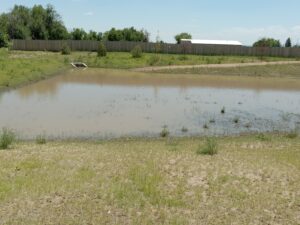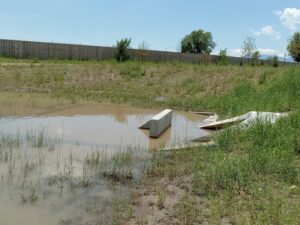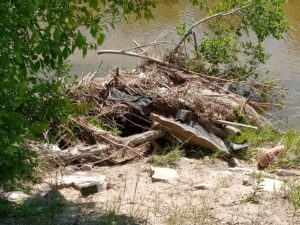
The rain we’ve been getting here in Southern Colorado has made the landscape unusually green — but it’s also meant that Pikes Peak Habitat’s construction crews need to be extra vigilant about stormwater runoff and erosion.
“Stormwater erosion control is really, really important for disturbed land,” explains Pikes Peak Habitat construction superintendent Eric Wells. “This is land that doesn’t have vegetation in it to hold the dirt in place. If you just have raw dirt, the rainwater and the stormwater can wash that dirt around, and it will eventually end up in our streets and our sewers and the creeks or the rivers that are heading downstream.”

The city of Colorado Springs has established a comprehensive stormwater program, which includes permits and protocols “that I as a builder really appreciate,” he says. “With their assistance and their inspections, I am able to be more aware of what dirt is washing off my lots and into the retaining ponds, and then it pushes me to do what I need to do to reduce the amount of dirt.”
Our construction site has a stormwater permit from the city. Inspectors visit biweekly and produce a report with any issues, including a three-day deadline to address those problems or face being shut down. “They take it very seriously, and so do we,” says Alex St. Clair, Pikes Peak Habitat construction supervisor.
Pikes Peak Habitat also has a developer permit from the state of Colorado, which has its own stormwater division. “If a builder fails to comply with this stuff, there are some heavy fines — and it’s not just one-time fines, it’s daily fines,” Wells explains.
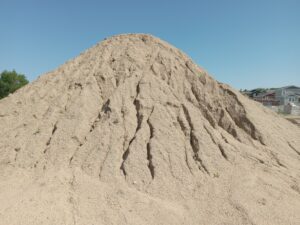
So efficient stormwater control has a lot of benefits: It keeps us in compliance with existing laws, helps us responsibly use our finances, stewards environmental resources, keeps the roads and sewers clean in our development, and preserves the beauty of Sand Creek both for homeowners here and for those living downstream.
After homes are finished and yards are landscaped, erosion control becomes less of an issue, because grass, plants, and rocks will hold most dirt in place. In the meantime, though, our construction crews take several steps to keep sediment out of the streets, sewers, and nearby Sand Creek.
Curb Cuts
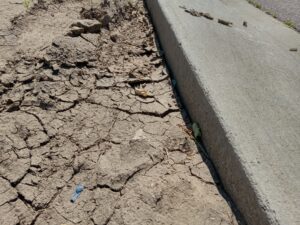
That gap you might notice at the concrete rim of the curb? It’s called a curb cut — and it’s an intentional strategy to help keep dirt on the lots.
“We cut the dirt away below the concrete curb, so there is this drop between the top of the concrete and the beginning of our lot,” explains Wells. “That drop allows it to kind of get filled up over time as dirt runs, and then we can just recut it as it fills back up.”
Straw Wattles
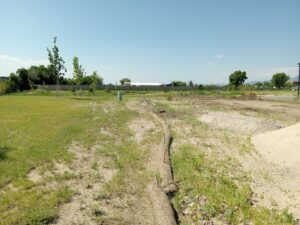
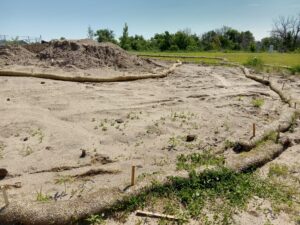
Curb cuts don’t work for every situation. For example, dirt might run into an area that’s already landscaped or planted with grass, or a sloped lot might lose more dirt than a curb cut would contain. For those situations, the construction crew uses straw wattles.
“These are eight-inch tubes of straw that are encased in a plastic netting, and they’re really long,” explains Wells. “You can roll them out, and every 12 inches we throw a wooden stake in to keep them in place. They do a really great job of acting similar to a curb cut. When dirt flows up against them, the water is able to go through, and the dirt stays against them.”
They’re biodegradable, too. “As they start to fill up or decay away, we replace them and start all over again,” Wells says.
VTCs
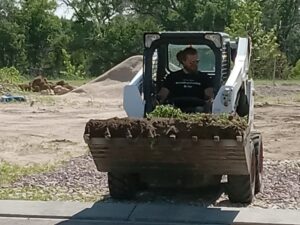
Another way dirt can end up in roadways is when it gets caught in tires of construction equipment that’s traveling between building lots and streets. To avoid this, we use vehicle tracking control (VTC).
There are various ways to create VTCs using different materials. “We use sharp, crushed granite, and we kind of fill in our curb cut when we’re going to be driving over that and extend it into the lot,” Wells explains, “so that as the track rolls over it, this sharp, pointy granite will knock the dirt off the tires of our Bobcat.”
Rock Socks

“Every storm event creates some sediment in the road and creates stuff that has to be cleaned up,” says St. Clair. Our stormwater control plan includes “preventing the storm sewers from getting filled with sediment, because that’s really expensive to remove,” he explains.
So “rock socks” made of heavy sandbags and other filters are placed in front of storm drains, allowing water through but trapping larger particles, gravel, and rocks.
Street Cleaning
Even with all the precautions we take, some dirt does end up in the street, thanks not just to the rain but also to wind.
“Keeping sediment cleaned out of the road is a big deal to the city of Colorado Springs, so we stay on top of it,” explains St. Clair.
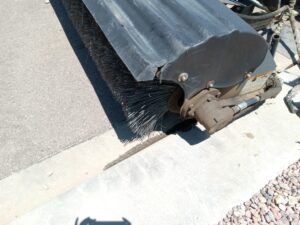
“In the past we’ve had volunteers and staff sweeping the dirt out of the streets,” says Wells. But recently, Lawrence Construction donated two skid-steer attachments. Wells describes them as “angled brooms. They are brooms that are hydraulically driven. It’s like a street-sweeper attachment for our Bobcat.”
He adds, “We’ve been wanting one of these for awhile, and we are just so incredibly exited to finally have one. It will be something that we can bring from site to site. and it will reduce the amount of time that we will be needing our volunteers and staff to be cleaning the streets.”
Retention Pond
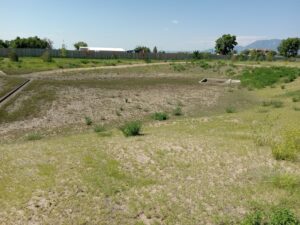
Curb cuts, straw wattles, VTCs, and rock socks are temporary measures, designed to control water runoff and dirt erosion while land is being developed. But even after construction is finished, rain will inevitably wash some dirt and other debris into the streets and nearby creek.
We have tools to address that as well.
“A permanent type of stormwater erosion control is like a catch basin. It’s called a retention pond,” explains Wells.

“All of the stormwater that runs into the gutters and into the stormwater inlets here at The Ridge at Sand Creek development is going to end up in that pond.”
To keep the creek from being flooded with runoff, the retention pond temporarily traps water, then releases it slowly after filtering out garbage and other debris.
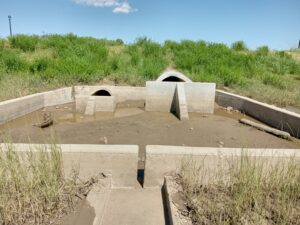
Gutters and street drains emerge into a concrete basin, which includes walls that stop rocks, trash, and other objects while allowing water to flow around them.
“At one end it has a skinny channel with a grill on top,” says Wells.
The channel runs across the retention pond area and “really slows the flow of water down quite a bit.” It leads to another drain with a grill on top. “If it starts to overflow, the grate on top will allow the water to flow much quicker,” says Wells. “It’s kind of like the overflow hole in your bathroom sink.”
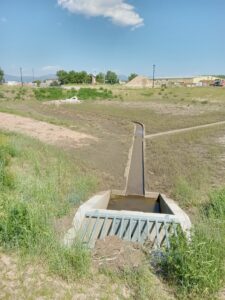
The grill also traps any debris that escaped the initial concrete basin.
The system drains onto the slope just above Sand Creek, where water can run down into the stream.
Testing the Safeguards
Wells says the heavy rains we’ve seen over the past month or so have definitely created extra work for the construction crew.
“We were constantly recutting the curbs,” he says. “We were unloading the wattles, which means getting the dirt out of them as well.”

He explains, “The rain coming down out of the sky picks up a lot more dirt than I think most people think. The harder it rains, the more water is there, the faster it can flow — and it can create deep channels on your lots. It can create deep channels on your stock piles. And that can quickly, quickly overrun onto the streets if not handled properly.”
We’re succeeding in handling it properly, though! When the city does their inspections, we have very few areas to improve, “and we always address it immediately,” he says.
“I want to have the mindset of being responsible for not only our neighbors who are living here in Sand Creek, but also the folks downstream as well,” adds Wells. “I feel like it’s easy to forget about the downstream effects of what we are doing, but it’s important.”
He concludes, “Overall, I’m really proud of how well we’ve been handling our stormwater control and our erosion control.”
